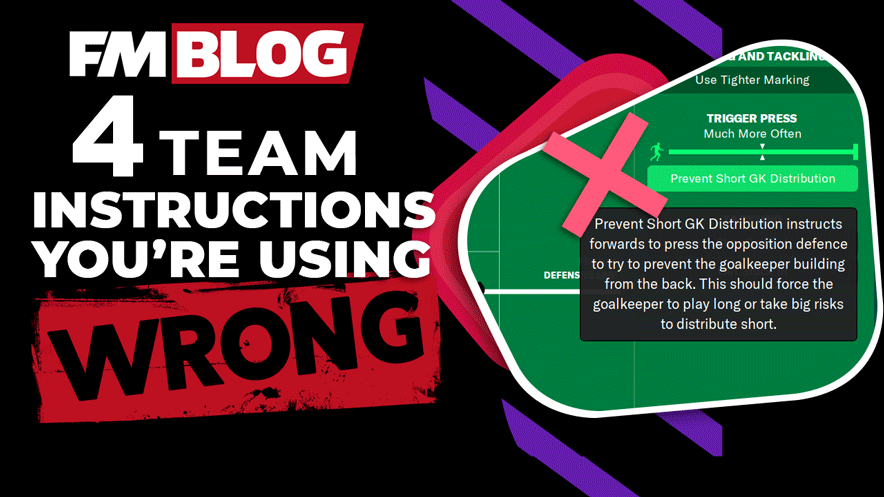This Football Manager guide is here to point out commonly misunderstood team instructions and why they might be doing you more harm than good.
Picture the scene: you’re setting up your tactic, you’ve got your formation nailed on, all your player roles set up for success, your mentality is ready to go, and then you come to your team instructions. You know how you want your team to play, but you’ve spotted a few extra instructions that sound like a good idea. Suddenly you notice your tactic isn’t working how you meant, and you’re leaving yourself exposed or not exploiting opposition weaknesses like you wanted. Let's see what you might be doing wrong.
1. Prevent Short GK Distribution
Wrong.
Think about it, if the goalkeeper can’t distribute short, what’s he going to do? Punt it long to a target man - or even worse, punt it long to your centre back and press him. This is an absolute gift to opposition GKs and centre backs, as this gives them an easy way to bypass your pressing. Letting opposition CBs receive the ball to feet is the best way to trigger your press, and forcing them to play a long ball completely misses that.
To use this successfully, you also need a DM and to defend narrowly so your midfield and defence can challenge for the second ball after your CB wins the header. Be careful not to leave too big a gap between your midfield and attack though, as this space can be exploited by a DM.
READ ALSO: How to Set Up Tactical Player Instructions on Football Manager
Andy Robertson, Kyle Walker, Alphonso Davies, Marcelo. Overlapping full-backs are a key part of the modern game and are such a useful weapon when used correctly.
Here’s the thing though, if you’re playing with wing-backs, you don’t have to look for overlaps. They’re already there.
Look again at the description of a wing-back:

The wing-back overlaps automatically. You don’t have to tell him to overlap. By telling your team to look for overlaps, you’re telling your midfield to wait until the wing-back makes the run before making a decision. This is fine if you’re playing a low-tempo considered possession game, but for a swashbuckling rapid counter-attacking game the last thing you want is for everyone to stop and wait for your wing-backs to get in position. Without “look for overlaps” selected, you’ll still get those runs, but the ball will move forward much quicker, which in many ways helps them because the defence doesn’t have time to prepare for it.
2. Look for Overlaps
Andy Robertson, Kyle Walker, Alphonso Davies, Marcelo. Overlapping full-backs are a key part of the modern game and are such a useful weapon when used correctly.
Here’s the thing though, if you’re playing with wing-backs, you don’t have to look for overlaps. They’re already there.
Look again at the description of a wing-back:

The wing-back overlaps automatically. You don’t have to tell him to overlap. By telling your team to look for overlaps, you’re telling your midfield to wait until the wing-back makes the run before making a decision. This is fine if you’re playing a low-tempo considered possession game, but for a swashbuckling rapid counter-attacking game the last thing you want is for everyone to stop and wait for your wing-backs to get in position. Without “look for overlaps” selected, you’ll still get those runs, but the ball will move forward much quicker, which in many ways helps them because the defence doesn’t have time to prepare for it.
3. Be More Expressive
The problem is, Be More Expressive is a general permission to your players to abandon their role if they see fit, and to impact the game in their own way. This is fine if you trust your players, but you may find that they’re shirking their defensive responsibilities, or not maintaining the width you’ve asked, or dribbling more than you expect. This button literally tells your players to disobey their instruction. So if you find your players are turning in undisciplined, unorganised and unstructured performances, take this instruction off.
4. More Often Pressing
If you’ve brought your team back into your own half, you’re defending deep, trying to nullify a better side - or trying to preserve a lead - you need solidity. You want your players to keep their shape and be difficult to break down. By leaving your pressing at more often or much more often, all that happens is the opposition brings the ball forward, and suddenly you’ve got players out of position. You’re chasing shadows while the opposition stroke the ball around like the Netherlands in the 70s, and they’re exploiting the spaces left by your players who have decided their own half is a great time to press. If you’re defending deep, keep everyone compact, and stop pressing. It’ll keep your team hard to break down and stop the opposition from waltzing into your penalty box.
LEARN MORE:
Mastering Football Manager - eBook






















